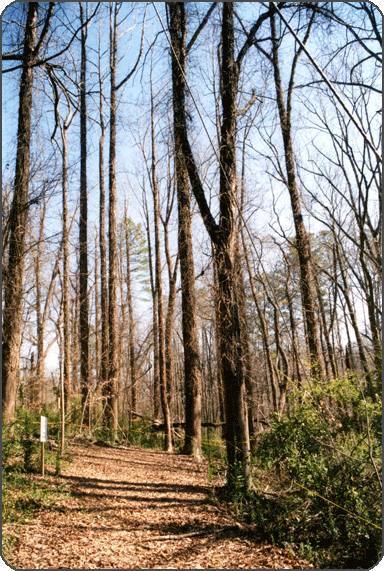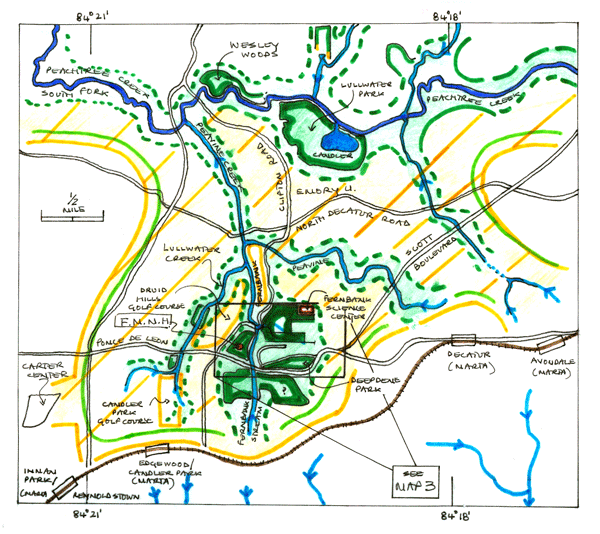MISSION STATEMENT
The mission of the Deep Forest Field School is to save forests.

Part of the Fernbank forest being eaten up by a mixture of invasive plant species

and after the trees were cleaned by Machete Man
The School is dedicated to forest conservation through a number of activities:
- It provides a specialized service, Machete Man, to control and eradicate invasive plant species in trees and woodlands in urban areas, particular in Atlanta, Georgia. Machete Man focuses on cutting away and killing Kudzu, Ivy, Wisteria, Honeysuckle, Privet and the Mountain Olives while carefully leaving the native trees unharmed and with special attention to protecting the tree seedlings and saplings that constitute the forest of the future;
[Go to the ‘Services’ section, and www.macheteman.com for more on these specialized services]
- It organizes Community Projects to take the direct, follow-up action necessary to maintain wooded areas free of invasive plant species after Machete Man has finalized the difficult “first cut”. The combination of the Machete Man effort and the community activity reverses the process of urban forest degradation;
[See the Video and find out more at the ‘Community’ link]
- It provides educational programs about forests to schools, and other community organizations. These programs address the science of the environment through structured field trips into local woodlands, i.e., experiential learning about the scientific principals that provide the framework for understanding forest ecology and the critical importance of forest conservation;
-
It offers a Consultation Service on forest conservation and related issues
- It maintains an Archive of books, papers, maps, and journals on forest and primate conservation
- It engages in efforts to increase the public’s awareness of the importance of protecting and conserving our urban trees and woodlands
From over 30 years of field experience studying aspects of forest ecology and conservation in the tropics, the Founder and Director of the School, Dr. J.F. Dahl (see “Founder”), began to realize that the southeastern forests of the United States were under considerable threat from the effects of invasive plant species. At the same time, the importance of forests as ‘sinks’ for carbon dioxide became more and more apparent as the evidence for global warming, and the scientific basis for understanding this process (the ‘Greenhouse Effect’), became more detailed and established. At a global level, saving forests preserves and increases the natural ability of the planet to absorb carbon dioxide from its atmosphere.
At the local level the benefits of preserving and extending our forested areas are more specific. Several sets of research results emphasize the critical importance of saving the larger and older trees of the urban forest, and eradicating kudzu from metropolitan areas. Firstly, -“a big tree does 60 to 70 times the pollution removal of a small tree” (Nowak, in Gray, 2007 {Bibliography after map/diagram below), so that saving a large tree in the urban forest is equivalent to planting 60 to 70 small trees in terms of pollution control in the first and many succeeding years. Secondly, work by Lerdau and his associates (e,g., Ashton et al., 2005; Lerdau, 2003 & http://oscar.virginia.edu/x11532.xml ) has led to the recent conclusion that soils with kudzu produce twice as much ozone than soils without kudzu. This is consequent to the invasive plant producing abnormally high amounts of nitrogen oxides (NOx) coupled with its production of isoprene. These substances interact to produce ground level ozone, a major contributor to unhealthy air conditions in Atlanta. Quite apart from the intrinsic benefits of maintaining high biodiversity, conserving the forest not only maintains and extends an important sink for carbon dioxide, but also acts as a sink for many harmful pollutants of the urban atmosphere. This is particularly the case where kudzu is eradicated since this actually reduces ‘natural’ ozone production as well as preserving the trees that remove carbon dioxide.
The process of insularization (see Soule & Wilcox, 1980) underlies the way invasive plant species take over and degrade urban forests, as well as other forested areas. As large tracts of wooded land are cut up into smaller and smaller pieces, they expose more and more forest edge through which the harmful vines and shrubs can invade. The specific aim of the School is to focus on the removal of invasive plant species from the remaining tracts of urban woodland, protect and conserve the biological corridors that link these wooded tracts, and create buffer zones around them that are also free of invasive species i.e., reverse the process of insularization while working to return the forest to a healthy and highly generative state. The first and major priority is the forest of greater Atlanta. Our immediate focus has been the forest of Fernbank that stands as an example of the Field School’s approach to urban reforestation (see Map below and Ecological Rationale in section on Invasives).

Schematic map of the Fernbank Forest area of Northeast Atlanta. The forest refugium of specific interest is centered at the Fernbank Museum of Natural Histpry (F.M.N.H.; dark and light green area, mid-center). The biological corridors are defined by broken green lines and the light green areas around the water courses (blue). The Buffer Zone is indicated by the yellow lines. The forest in and about Emory University to the north (Lullwater Park & Wesley Woods) constitute another core refugium.
Bibliography
Ashton, I., Gurevitch, J., Hyatt, L., & Lerdau, M. 2005. Invasive species accelerate decomposition and litter nitrogen loss in a mixed deciduous forest. Ecological Applications 15: 1263-1272.
Gray, D. 2007. Uprooted. Time [June 2nd] 169(27): 69-70.
Lerdau, M. 2003. Keystone molecules and organic chemical flux from plants. IN: Interactions of the Major Biogeochemical Cycles. SCOPE 61, pp177-192. Melillo, J., Field, C., & Molden, B. (Eds.). Island Press, Washington, D.C.
Soule, M. E. & Wilcox, B.A. (Eds.) 1980. Conservation Biology: An evolutionary-ecological perspective. Sinauer, Sunderland, MA.
